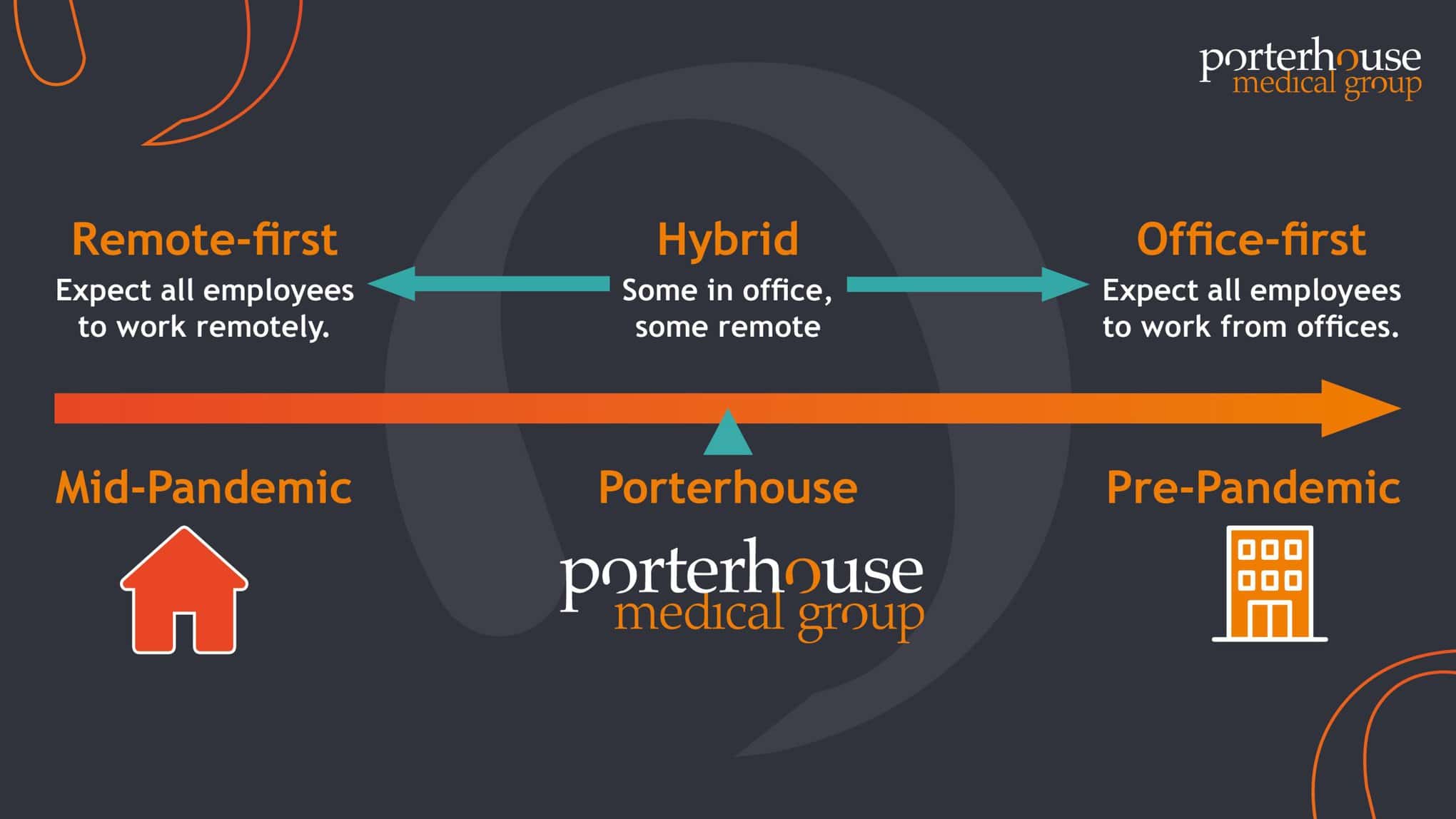Hybrid working: Insights and tips for success
January 18, 2022 | Hybrid working, Porterhouse Medical Group
Porterhouse Medical has thrived by embracing a hybrid approach to work. Our article looks at hybrid working and provides some tips for success

In January 2020, while the threat of a global COVID-19 pandemic was still in its infancy, 5.7% of UK workers reported working exclusively from home; by April of the same year, this figure had increased to 43.1% [1]. Since 2021, with the world recovering and the workforce returning, companies have been debating whether or not to adopt a new hybrid model that combines remote and office-based work – and whether to let their employees decide if and when they come into the office.
In a 2021 survey, 85% of remote workers in the UK wanted a hybrid approach to work [2]
Moving from an office-based to a hybrid model seemed like a change that could take years, and before the pandemic some industries claimed it would be impossible. However, in the wake of the pandemic, with lockdowns easing and workers having the option to return to the office, companies and their employees are embracing a new way of working. When UK restrictions began to ease in April 2021, 24% of businesses stated they intended to increase the amount of homeworking they allowed [2]. The pharmaceutical industry has embraced this attitude, with some of the biggest names acknowledging the need to adapt [3, 4].
Alongside the pharmaceutical industry, medical communications has moved away from office-based working to the ‘new normal’ that is hybrid working. Before the pandemic, data from the Office for National Statistics showed that within the information and communication industry, 53% of employees worked from home in some capacity [5]. In comparison, during the pandemic the 2021 Healthcare Communications Salary Survey found that approximately 90% of respondents had been offered ‘working from home’ as a benefit [6]. As the expectations of employees change, businesses will be expected to adapt, and for now at least, hybrid working seems to be only growing in popularity.
46% of UK workers experienced loneliness during lockdown [7]
Prior to the pandemic, some companies were resistant to adopting remote or hybrid working. Companies cited security and equipment issues as limitations, which were problems that businesses either didn’t know how, or want, to solve. The rapid onset of lockdown meant that businesses had to adapt to homeworking almost overnight, forcing them to overcome many of these issues regardless of costs. Another fear was that having employees away from the office would reduce the amount of supervision they received, and that managing a team remotely would be too difficult. This would then lead to reduced productivity and decreased morale.
The pandemic has created an opportunity to determine the effect that remote working, and the hybrid approach, has on the workforce. The ability to work flexible hours, the lack of a commute and the resulting increase in time to spend with family and pets all helped to form a more positive working culture. The biggest risks to employee motivation were loneliness and burnout. Data from 2020 indicated that, compared with those who did not work from home, employees who worked from home were more likely to work unpaid overtime, increasing the risk of burnout [8]. However, these problems were not solely due to remote working. The restrictions in place at the time limited interactions with family and friends and prevented people from doing the hobbies that, under normal circumstances, allowed them to unwind from work. Although many companies tried to mitigate this with online socials, food deliveries and virtual activities, there was only so much they could achieve. Another concern has been the effect that remote working (either permanent or as part of a hybrid strategy) has on lines of communication within a company. Businesses feared that having employees communicate virtually would have a negative impact on working relationships.
As both social and professional in-person events return, some of these risks should decrease. During the pandemic we were entirely separate, but a hybrid model provides the best of both worlds. When employees want to socialise and need to have face-to-face meetings the office is available, but when they feel the need to focus, they can choose to work from home. This approach allows employees to work according to individual style, providing flexibility that not only maximises productivity but also helps to combat the risk of burnout. Companies who adopt a hybrid strategy also promote Mental Health First Aid (MHFA) training, which teaches people how to identify, understand and support other employees who may be experiencing mental health difficulties. This level of mental health support is becoming more frequent; in 2021, MP Dean Russell put forward a Bill to make MHFA training a legal requirement in the workplace [9]. If a supportive network is established (both virtually and in-person), a hybrid working model offers the advantages of remote working while simultaneously reducing the risks commonly associated with it.
The Porterhouse Approach
At Porterhouse, we have thrived by embracing a hybrid approach to work. Here are just some of the strategies we have used to support hybrid working:
- Supporting social connections using regular online and face-to-face check-ins, such as weekly town hall meetings and Beer o’clock Friday
- Empowering staff by letting them decide when to use our office spaces
- Ensuring all employees have an ergonomic and comfortable working environment, with the equipment they need, both at work and at home
- Providing secure access for data storage and remote access to allow smooth transition between home and office
- Building a supportive work environment via mentorship and Mental Health First Aid programmes
These strategies help to create a supportive environment that builds on Porterhouse values. Empowering staff our and providing essential resources allows us to work passionately and take pride in our work. Despite over 18 months of remote working, we have maintained and continue to develop strong bonds that allow us to work together as a family. Embracing a hybrid working approach has allowed Porterhouse to flourish, and individuals within Porterhouse have made the most of our hybrid approach. Here are some of their thoughts on why hybrid working has been such a success:
Alexander Williamson, Senior Medical Writer
“I like to work in the office most of the time for the social environment and for ease of collaboration, but I find the option to work from home really helps when I need to put aside a block of time when I need to do focused work without interruptions or distractions.”
Erica Cave, Associate Scientific Services Director
“Hybrid working allows you to experience the best of both worlds: you can take the time to focus on a project in peace at home but collaborate and share ideas with colleagues in person when you visit the office.”
Risa Tomioka, Associate Editor
“Hybrid working gives me the opportunity to experience the friendly and welcoming office environment and to really focus on my work at home when needed. It’s also great that I can continue working from home if any unexpected situations arise.”
Alice Wright, Associate Account Director
“The freedom to choose whether to work from home or in the office has been amazing for managing my work-life balance. I’m able to work from home when I need to focus or need more time for life admin and family commitments, but can also work from the office when needed, for more social interaction and to collaborate with colleagues, or to have a break from the family!”
At the start of 2022, Porterhouse Medical Group is looking forward to a new and exciting year, with great plans for continued growth and the development of our valued teams.
There has never been a better time to join us!
For information about our vacancies, please visit our careers page at porterhousemedical.com/careers or contact Jan Coetzee at jan.coetzee@porterhousemedical.com.
References
- Wales Institute of Social and Economic Research and Data. Homeworking in the UK: Before and during the 2020 lockdown. Available at: https://wiserd.ac.uk/publications/homeworking-uk-and-during-2020-lockdown. Accessed November 2021.
- Office for National Statistics. Business and individual attitudes towards the future of homeworking, UK: April to May 2021. Available at: https://www.ons.gov.uk/employmentandlabourmarket/peopleinwork/employmentandemployeetypes/articles/businessandindividualattitudestowardsthefutureofhomeworkinguk/apriltomay2021. Accessed November 2021.
- myHRfuture. How Bayer is redefining the workplace around purpose, innovation and culture (interview with Melissa Harper). Available at: https://www.myhrfuture.com/digital-hr-leaders-podcast/2020/11/17/how-bayer-is-redefining-the-workplace-around-purpose-innovation-and-culture. Accessed November 2021.
- Bloomberg. Novartis chief sees remote-work hybrid persisting after pandemic. Available at: https://www.bloomberg.com/news/articles/2021-04-27/novartis-chief-sees-remote-work-hybrid-persisting-after-pandemic. Accessed November 2021.
- Office for National Statistics. Technology intensity and homeworking in the UK. Available at: https://www.ons.gov.uk/employmentandlabourmarket/peopleinwork/employmentandemployeetypes/articles/technologyintensityandhomeworkingintheuk/2020-05-01. Accessed November 2021.
- MedComms Networking. 2021 Healthcare Communications Salary Survey. Available at: http://medcommsnetworking.com/surveys.html. Accessed November 2021.
- Totaljobs. Lockdown loneliness & the collapse of social life at work. Available at: https://www.totaljobs.com/advice/lockdown-loneliness-the-collapse-of-social-life-at-work. Accessed November 2021.
- Office for National Statistics. Homeworking hours, rewards and opportunities in the UK: 2011 to 2020. Available at: https://www.ons.gov.uk/employmentandlabourmarket/peopleinwork/labourproductivity/articles/homeworkinghoursrewardsandopportunitiesintheuk2011to2020/2021-04-19. Accessed November 2021.
- UK Parliament. First-Aid (Mental Health) Bill. Available at: https://bills.parliament.uk/bills/2847. Accessed November 2021.
 Author: Steven Gibney | Associate Medical Writer | Porterhouse Medical
Author: Steven Gibney | Associate Medical Writer | Porterhouse Medical
This content was provided by Porterhouse Medical Group




